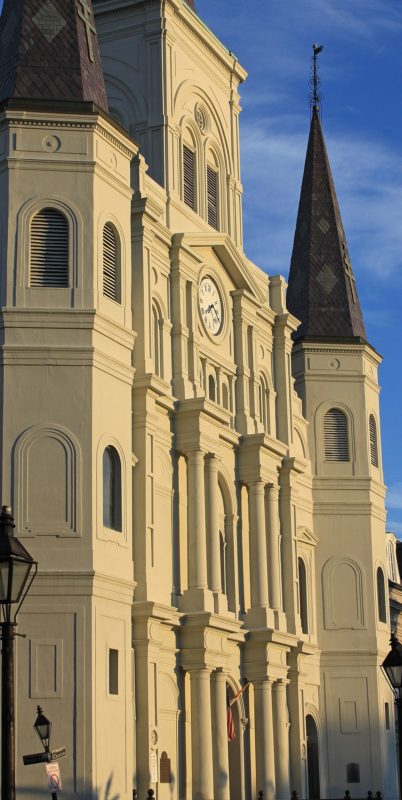A colleague of mine with a large fan base recently tweeted that his reason for getting a PhD was a love for writing and teaching. People will confess to almost anything on social media, even their worst afflictions. I, for one, sympathized. Still, I couldn’t help but wonder how a slight adjustment to this combination of loves might have led to an entirely different and more appealing life-path.
If one loved biking and teaching, for instance, one could lead bike tours in some historically rich city, like New Orleans. I recently went on a half-day bike tour of New Orleans with my family, and we were taught quite a lot by our knowledgeable guide, John.

Uncommon angle, St. Louis Cathedral, New Orleans. DVehlow [CC BY-SA 4.0 (https://creativecommons.org/licenses/by-sa/4.0)]
“We won’t be talking about slavery,” he added.
The comment struck me, and I understood it in several ways. Sometimes the light will dim in the eyes of my students in the US History survey, as if to say, “He’s going to talk about slavery again, kill me now.” All I can say is, I know, I know. The topic can bring you down.
This semester I’m teaching an upper level African American history course for undergraduates, and I’ve about had it with the topic myself. Trying to cover all my bases for a class on Nat Turner, I finally got around to watching The Birth of a Nation, the recent film by Nate Parker. In one early passage, Nat’s master is renting him out to preach obedience to the slaves on neighboring plantations. Here the film punches hard, depicting the cruel squalor and indignity whites forced on blacks in order to profit off them, their flesh and their lifeblood. “I’ve had enough,” I remember thinking.
John’s customers were folks on vacation. They weren’t looking for a heavy ordeal.
I read an article once by a guide who gave tours at a southern plantation, who had to deal at times with a hostile contingent eager to argue whether slavery was really so bad. “We won’t be talking about slavery,” made sense from this angle, too. John wouldn’t want to get into it with some idiot with an ax to grind. His job was to keep things upbeat and move us along.
John was a ropy, tall man, forty-ish, weathered, very slim, some cool tats, a notable haircut. Later I asked my kids what they remembered about him. My daughter described his earrings and polished nails. My son remembered his zip-up leather jacket and how quickly he spoke. Both liked him. I liked him, too, but also took a professional interest. We would bike for a while, following John single file, and then he’d gather us somewhere and deliver a blast of information. Sometimes you have to talk fast when you’re on a schedule and trying to fit it all in. His talks were like my lectures, not delivered each time word-for-word but very well-practiced, all the same. He would state a point, a concept, fill in some detail, give an example or two, and then come back and restate the point. He was doing what I try to do, to usher a few bits of information through my students’ brains, from the short- to the long-term memory.
And doing a good job of it, too. There were a number of things I learned on the tour that I’m not likely to forget. The difference between a balcony, a gallery, and a veranda. The technology of an above ground tomb. The sixty years of French rule, the forty years of Spanish, before the Americans took charge. Grasping this rough chronology gave me a new appreciation of the city’s history. Something took root in that single century, something particular, that continues to bear fruit to this day.
In preparation for our trip, I had re-watched “Gumbo,” the first episode of Ken Burns’ documentary series, Jazz. Wynton Marsalis is one of the great voices in that series, articulating much about the music and the city that gave it birth. “Jazz music celebrates life, human life, the range of it, the absurdity of it, the ignorance of it, the greatness of it, the intelligence of it, the profundity of it–and it deals with it.”

A fern grows in the masonry of a tomb in a New Orleans cemetery.
I remembered this quote as we wheeled down the boulevards that serve as the borders between neighborhoods—“neutral ground,” John told us. It reminded me of David Simon’s HBO series, Tremé, about post-Katrina New Orleans. Simon’s argument in that series can be boiled down to the following: look what we almost lost; look what we’re still in danger of losing.
One of the members of our party, a Californian traveling with her husband, had Katrina on her mind. “Was this part flooded?” she would ask as we crossed from one neighborhood to another. John would answer without elaboration. Finally he said, with a touch of exasperation, “We’ve been here three hundred years—that was just one storm.” Katrina played such a role in George W.’s political fortunes, and perhaps in the election of his successor, I wondered if the topic wasn’t another racially-charged minefield that required steering around.
And yet I began to notice that we weren’t always on neutral ground. Andrew Jackson may have won the battle of New Orleans, John admitted, but otherwise was “not a good guy.” Slavery would get a mention after all, it turned out, as would the Trail of Tears. In the cemetery we visited, among the somber, rough and crooked tombs slowly baking their contents into ash was a castle-shaped mausoleum, built of polished stone, with wooden doors and stained-glass windows, and outfitted with climate-control. Our affable guide didn’t hide his disapproval. All it lacked, he suggested, was a disco ball.
Other remarks were dropped here and there, some choice commentary, let’s say, to go along with the facts. Interpretation wasn’t totally absent. It was just that things were carefully managed as to restrict it to a single source. In this, too, I recognized a kinsman. I have my captive audience. I like to deliver my point of view. And I tend to manage, at least most of the time, to avoid controversy or disagreement. But I’m not going to explore the matter further. Let’s keep things upbeat and move along.

4 Thoughts on this Post
S-USIH Comment Policy
We ask that those who participate in the discussions generated in the Comments section do so with the same decorum as they would in any other academic setting or context. Since the USIH bloggers write under our real names, we would prefer that our commenters also identify themselves by their real name. As our primary goal is to stimulate and engage in fruitful and productive discussion, ad hominem attacks (personal or professional), unnecessary insults, and/or mean-spiritedness have no place in the USIH Blog’s Comments section. Therefore, we reserve the right to remove any comments that contain any of the above and/or are not intended to further the discussion of the topic of the post. We welcome suggestions for corrections to any of our posts. As the official blog of the Society of US Intellectual History, we hope to foster a diverse community of scholars and readers who engage with one another in discussions of US intellectual history, broadly understood.
Anthony,
Thanks for this.
On a bike tour for tourists one might want to minimize slavery, but I think it would be harder to do in the classroom, given New Orleans’ importance in the slave trade etc.
There are also connections to the slave revolution in Haiti. A main reason the French were willing to sell New Orleans to the U.S. was that the “loss” of Haiti and its slave-produced sugar made the port of New Orleans less important to the French commercially. That’s very oversimplified I’m sure, but there is a connection between the Haitian Rev and the Louisiana Purchase.
Anyway, good post.
Not only harder to do in the classroom but impossible to do. Yes, I think our guide did mention Haiti. He was good at his job. He didn’t use the term “the Black Atlantic”–explanation of that useful term would have cut down on our biking time significantly.
Thanks for reading, Louis.
Hi Dr. Chaney: I enjoyed your post. Just a question- Did you mean to say “remake” of The Birth of a Nation ( 1915)?
“I finally got around to watching The Birth of a Nation, the recent film by Nate Parker”.
Thank you for the question. The 2016 film by Nate Parker, The Birth of a Nation, is based on the Nat Turner rebellion. It isn’t a remake of the 1915 classic silent film by D. W. Griffith, but of course Parker gave his film the same name as the earlier film to make a point.
Griffith’s film, as you may know, is based on the 1905 novel, The Clansman. I recently learned (from the 2017 documentary, Birth of a Movement) that it was Thomas Dixon, the author of The Clansman, who suggested the subsequent title to Griffith. If I’m remembering the chronology correctly, Griffith and Dixon were expecting protest from civil rights organizations, and the new title was an attempt to give the story a broader framing.